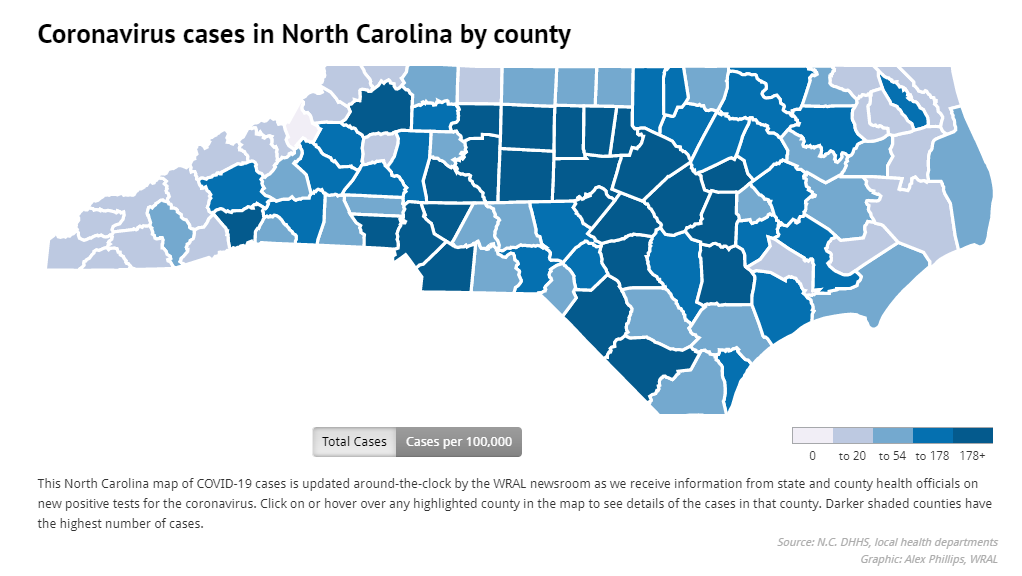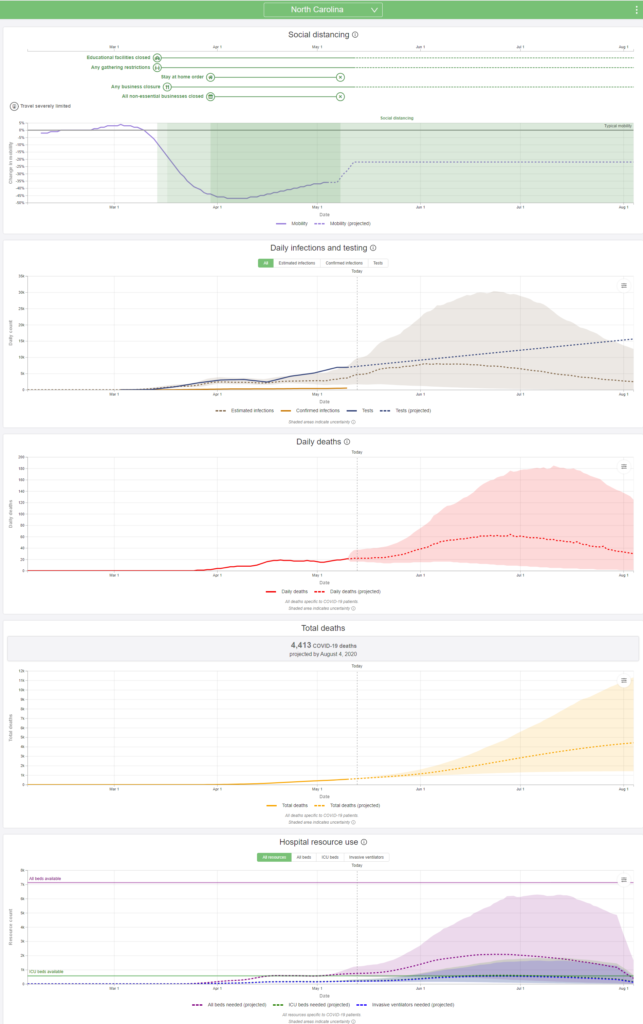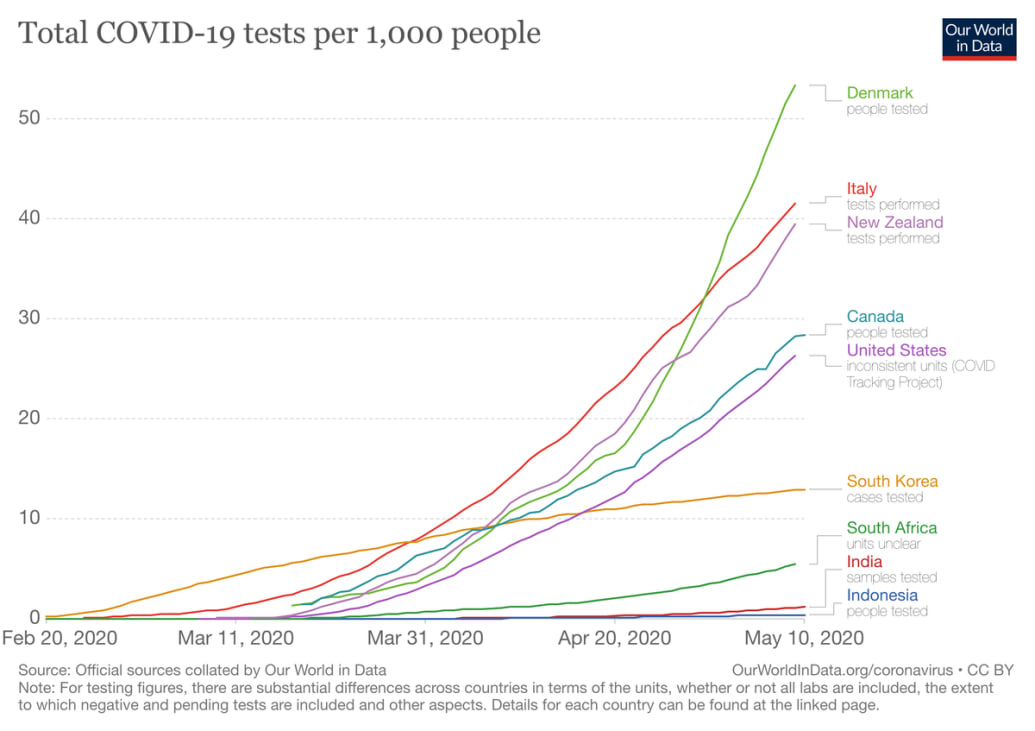World:

U.S.:


NC and local:




A little fact check on Trump’s little “victory” lap Monday:
It had all the trappings of a “Mission Accomplished” moment: the banner, the presidential pomp, and a message that wasn’t true.
But what President Donald Trump wanted Monday to be a show of strength over his administration’s coronavirus testing push, complete with a banner touting “AMERICA leads the world in testing,” ended under tough questioning by reporters, causing the president to storm off abruptly.
When CBS reporter Weijia Jiang asked Trump why it was a competition to the president with those around the globe as the death toll climbs and cases increase, the president used his answer to go on the attack.
“Well, they’re losing their lives everywhere in the world,” Trump said. “And maybe that’s a question you should ask China. Don’t ask me, ask China that question, OK? When you ask them that question, you may get a very unusual answer.”
When another female reporter, CNN’s Kaitlan Collins, tried to ask a question, the president got into a brief exchange before ending the event.
Trump declared Monday that the United States had “prevailed” on testing, saying the nation will “transition into greatness.”
“We have met the moment and we have prevailed,” Trump said. Just two weeks ago, in another press conference, the president said that while his administration had made significant progress in scaling testing, it still had work to do. Monday’s announcement seems to indicate that the president thinks his team did all it needed to on testing in the last 14 days.
On Monday night, the nation’s coronavirus death toll had surpassed 80,000, according to Johns Hopkins University.

The United States trails countries like Denmark, Italy, and New Zealand for the total number of COVID-19 tests per 1,000 people, according to Our World in Data, as well as the daily number of tests per 1,000 people. While the U.S. is testing a great many people, according to Vox, it is also a large country, with a great many people to test.
In other words, the U.S. is hardly the global testing leader Trump portrayed it to be.
And the testing number touted by Trump on Monday evening is also behind schedule. In March, Vice President Mike Pence told reporters that by the middle of the month the administration would have shipped 4 million tests. He suggested that the country would, too, test that many people by the end of the month. “Before the end of this week, another 4 million tests will be distributed,” he said. That never happened.
When pressed by reporters at a press conference last month, Pence said the media was confused—that he meant the administration would facilitate the shipment of those tests and it was up to the states to administer them. It was yet another indication that the administration’s promises on testing fell short of expectations.
Testing for the virus has continued to be a sore spot for Trump during the pandemic, as the public’s ability to actually get tested for the virus has proven to be difficult.
For the past two months, state and local officials have pleaded with the federal government for assistance on testing, claiming they simply did not have enough tests or supplies to administer them to safely and completely reopen their economies. Trump has deflected criticism, claiming the federal government has gone above and beyond to help states get back on their feet. Trump’s son-in-law, Jared Kushner, earlier this month even called the federal government’s response a “success story.”
But that rosy picture is a far cry from the reality on the ground in local communities, especially those in hot spot areas. In Jersey City, New Jersey, the mayor and his team fought the state and the federal government for additional testing resources before settling on the idea that they would never have enough tests no matter how much they asked for help. And in other communities officials say that they do not have the staff or supplies to administer the tests they have on hand.
These anecdotes seem to have blowon past officials in the White House, including the president and Kushner, who have spent the majority of the last two weeks publicly praising each other.
States across the country have continued to reopen, despite concerns from some local officials about the speed of restrictions being eased and testing shortage worries.
Slides used by officials during the briefing touted the “historic scaling of testing,” along with the administration’s announcement that $11 billion was being sent to the states, via the CARES Act legislation, to be “devoted to testing capability.”
Trump also struggled to strike a balance at times during Monday’s briefing.
To one reporter’s question, Trump said, “If somebody wants to be tested right now, they’ll be able to be tested.”
Minutes later, Trump echoed again that “if people want to get tested, they get tested,” before bragging about the nation’s testing capacity.
“If people want to get tested, they get tested,” Trump said. “But for the most part, they shouldn’t want to get tested. There’s no reason. They feel good, they don’t have sniffles, they don’t have sore throats. They don’t have any problem.”
So, he lied. Of course. In fact, he was brittle and testy and he acted like a child, as usual. And demonstrated once again that he simply doesn’t understand this pandemic or the economic challenges and he’s making it worse.
It’s been 111 days since the first reported case of the coronavirus in the United States. It’s been 57 days since President Trump issued social-distancing guidelines, and 12 days since they expired.
Yet the Trump administration still has no plan for dealing with the global pandemic or its fallout. The president has cast doubt on the need for a vaccine or expanded testing. He has no evident plan for contact tracing. He has no treatment ideas beyond the drug remdesivir, since Trump’s marketing campaign for hydroxychloroquine ended in disaster. And, facing the worst economy since the Great Depression, the White House has no plan for that, either, beyond a quixotic hope that consumer demand will snap back as soon as businesses reopen.
Echoing his breezy language in the earliest days of the pandemic, Trump has in recent days returned to a blithe faith that the disease will simply disappear of its own accord, without a major government response.
“I feel about vaccines like I feel about tests: This is going to go away without a vaccine,” Trump said Friday. “It’s going to go away, and we’re not going to see it again, hopefully, after a period of time.”
And because he has a cult following, we now have to be as afraid of many of our fellow Americans as we do of the virus.
But Fauci testified yesterday in the Senate, and expressed his concern that we are opening up the economy too quickly. He reminded everyone of the obvious: if we have more outbreaks, we will see a rise in the death toll AND hurt the economy.
From the AP this morning, we get access to the CDC’s draft recommendation for opening up the economy, which was rejected by the White House.
Hopefully, state governors will grab THIS document and heed it:
There’s other examples of White House meddling with the CDC:
The White House has pressed the CDC, in particular, to work with states to change how they count coronavirus deaths and report them back to the federal government, according to two officials with knowledge of those conversations. And Deborah Birx, the coordinator of the administration’s coronavirus task force, has urged CDC officials to exclude from coronavirus death-count reporting some of those individuals who either do not have confirmed lab results and are presumed positive or who have the virus and may not have died as a direct result of it, according to three senior administration officials.
Officials inside the CDC, five of whom spoke to The Daily Beast, said they are pushing back against that request, claiming it could falsely skew the mortality rate at a time when state and local governments are already struggling to ensure that every person who dies as a result of the coronavirus is counted. Scientists and doctors working with the task force, including Anthony Fauci, the head of the National Institute of Allergy and Infectious Diseases, have said the U.S. death-toll count is likely higher than is being reflected in government data sets. And several local officials in hot spot areas said they’ve seen hundreds if not thousands more deaths over the last two months than in the same time period over the last several years. They presume many of those individuals contracted the coronavirus.
Orwellian.
More than 82,000 people in the United States have died of COVID-19 as of Tuesday. How many more lives will be lost? Scientists have built dozens of computational models to answer that question. But the profusion of forecasts poses a challenge: The models use such a wide range of methodologies, formats and time frames that it’s hard to get even a ballpark sense of what the future has in store.
Enter Nicholas Reich, a biostatistician at University of Massachusetts Amherst. Reich and his colleagues have developed a method to compare and ultimately to merge the diverse models of the disease’s progression into one “ensemble” projection. The resulting forecast is sobering. By June 6, it projects, the cumulative death toll in the U.S. will reach 110,000.
Reich’s approach builds on work he has done over the past four years for the Centers for Disease Control and Prevention, pulling together the many forecasts that U.S. experts create annually to predict how that year’s seasonal influenza will play out.
Reich’s team has set up asimilar system to compare coronavirus models. It’s a sort of portal through which the scientists behind each COVID-19 model can communicate key details about their methodology and results so that, as Reich explains, “all of these forecasts can be represented in a single standardized way. And this makes it really easy to make apples-to-apples comparisons between these models.”
The team unveiled the first version four weeks ago and ever since has been adding in more forecasts and updating the projections weekly. The latest update — released Tuesday — incorporates eight models, including some oft-cited ones, such as those built by the Imperial College London, the University of Washington Institute for Health Metrics and Evaluation, Columbia University and Northeastern University. (The team also sends each week’s release to the CDC, which publishes a version with a slight time lag.)
The projections vary substantially — with the most pessimistic forecasting a total death toll of 120,000 by June 6 and the most optimistic forecasting 103,000 deaths by that date. But the models have been inching closer to each other. Over the past several weeks, the distance between the highest and lowest estimates has halved from a gap of 36,000 deaths two weeks ago to a gap of 17,000 deaths in the most recent update released Tuesday.
